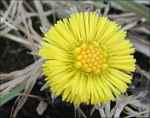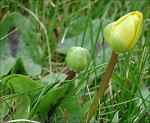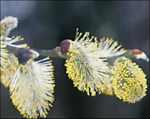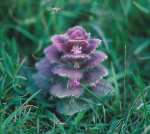Spring comes late to Caithness. Grass grows at
temperatures above 8.5oC and this temperature is not
regularly attained until mid-April. And since there are no big
areas of woodland, there are none of those plants that put their flowers
out early to get the benefit of the light before the leaves come on the
trees.
There are some prominent aliens, which have been
planted in the wild to brighten up the spring. Notably daffodils and
snowdrops have been introduced. The daffodils prosper but do not spread,
while the snowdrops have spread and produce wonderful displays under
trees.
Butterburr
- Butterburr is an invading alien flowering in February.
 Another spreading alien that is perhaps less
appreciated is the white butterburr (Petasites albus) now present
in substantial colonies in Wick (below the Assembly Rooms), Castletown
(West end of the beach), Thurso (Riverside walk) and Latheronwheel (by
the old bridge).
Another spreading alien that is perhaps less
appreciated is the white butterburr (Petasites albus) now present
in substantial colonies in Wick (below the Assembly Rooms), Castletown
(West end of the beach), Thurso (Riverside walk) and Latheronwheel (by
the old bridge).
Coltsfoot - Coltsfoot is a native plant flowering in March.
 Coltsfoot (Tussilago farfara) is a native wild
plant which puts out its flowers in March and later its leaves will
emerge with the outline of a colt's footprint. It is a widespread
coloniser of disturbed ground.
Coltsfoot (Tussilago farfara) is a native wild
plant which puts out its flowers in March and later its leaves will
emerge with the outline of a colt's footprint. It is a widespread
coloniser of disturbed ground.
Lesser Celandine - Lesser Celandine has heart-shaped leaves with a dark mark.
 The first of the buttercup family to flower is the
lesser celandine (Ranunculus ficaria). It occurs in two
sub-species in Caithness - the most common is that which produces little
bulb-shaped tubers in its leaf axils and spreads by them being spread
around - Ranunculus ficaria ssp. bulbilifera, while the less
common and more convincingly natural one is Ranunculus ficaria ssp
ficaria which lacks these tubers and spreads by seed in rough
grassland habitats.
The first of the buttercup family to flower is the
lesser celandine (Ranunculus ficaria). It occurs in two
sub-species in Caithness - the most common is that which produces little
bulb-shaped tubers in its leaf axils and spreads by them being spread
around - Ranunculus ficaria ssp. bulbilifera, while the less
common and more convincingly natural one is Ranunculus ficaria ssp
ficaria which lacks these tubers and spreads by seed in rough
grassland habitats.
Primrose -
Primroses prefer grassy slopes and flower early.
 The common primrose (Primula vulgaris) shows
its flowers early on grassy banks.
The common primrose (Primula vulgaris) shows
its flowers early on grassy banks.
Catkins - Male catkins of the Goat Willow make an early show.
 Trees and shrubs often put out their flowers early,
before the leaves. Willow, birch, alder and hazel put out catkins, often
of a single sex; the male ones are yellow with pollen, while the female
ones often less prominent.
Trees and shrubs often put out their flowers early,
before the leaves. Willow, birch, alder and hazel put out catkins, often
of a single sex; the male ones are yellow with pollen, while the female
ones often less prominent.
Ajuga - The Pyramidal Bugle is nationally scarce and flowers in May.
 And one special plant in the North that flowers in
mid May is the pyramidal bugle Ajuga pyramidalis. I know of it in
the Thurso river valley and in the Langwell strath, but there are old
records for the Reay area, the Shebster/Halkirk area and Berriedale. Can
anyone re-locate these? It is a nationally scarce plant with its main
population in West Sutherland and the Western Isles.
And one special plant in the North that flowers in
mid May is the pyramidal bugle Ajuga pyramidalis. I know of it in
the Thurso river valley and in the Langwell strath, but there are old
records for the Reay area, the Shebster/Halkirk area and Berriedale. Can
anyone re-locate these? It is a nationally scarce plant with its main
population in West Sutherland and the Western Isles.
Mayflower - Found In ditches and damp
grassy places in May.
 The mayflower or cuckooflower, (Cardamine
pratensis) is aptly named and brightens up the month in ditches and
damp grassy places
The mayflower or cuckooflower, (Cardamine
pratensis) is aptly named and brightens up the month in ditches and
damp grassy places




 Trees and shrubs often put out their flowers early,
before the leaves. Willow, birch, alder and hazel put out catkins, often
of a single sex; the male ones are yellow with pollen, while the female
ones often less prominent.
Trees and shrubs often put out their flowers early,
before the leaves. Willow, birch, alder and hazel put out catkins, often
of a single sex; the male ones are yellow with pollen, while the female
ones often less prominent.
